 |
 |
|
 |

Background
Coral reefs, like rainforests, are very complex environments. Just as rainforest trees provide a living three-dimensional landscape for thousands of smaller plants and animals, corals and coralline algae form the reefs and atolls upon which a great diversity of marine life flourishes. Our understanding of the larger plants and animals that compose the reefs and surrounding habitats of the Northwestern Hawaiian Islands – the corals, fishes, macro algae, sea turtles, and mammals – is fairly comprehensive, but our knowledge of the smaller, even microscopic life forms is not nearly as complete. These organisms are the barely visible, the extremely well camouflaged, those that live their entire existence within a tiny patch of sand or rubble, or even within another organism. Just trying to find these minute organisms takes a special knowledge of their habits and preferred environments. Once found, identifying them is even more challenging, sometimes taking years, with many experts involved. Despite their small size, some of these organisms, such as the marine zooplankton, rival all terrestrial animals in the scope and scale of their activities with daily migrations from the ocean depths to sunlit surface waters where they feed on microscopic plants, and their return to the dark abyss at dawn.Scientific understanding of the marine realm is many years behind our knowledge of terrestrial environments, and NOAA estimated in 2000 that we have explored only 5% of our oceans, despite the fact that the majority of our planet’s surface is water. Census of Marine Life (CoML), Census of Coral Reefs (CReefs) expeditions will provide baseline coral reef biodiversity information to assist managers globally and will also contribute to the greater CoML goal: “to assess and explain the diversity, distribution, and abundance of marine life in the oceans – past, present, and future.” CoML, a ten-year initiative, is composed of a growing network of researchers in more than 73 nations. Not only are these scientists seeking to assess and explain biological diversity throughout the world’s oceans, but they are doing it in such a way that their findings can be easily shared with other researchers, managers, and the public through techniques such as DNA barcoding of organisms, and by populating vast online databases such as the CoML Ocean Biogeographic Information System (OBIS). With this expedition and future research cruises, CReefs will help OBIS in its creation of a massive and dynamic catalogue of life in our oceans, allowing users to view species distribution globally. Furthermore, information from CReefs efforts will aid managers in understanding coral reef ecosystem changes over time and how to manage these systems. A project under CoML, the History of Marine Animal Populations (HMAP) is looking through historic records to evaluate what our ocean life used to look like, particularly before the days of industrial exploitation. CoML’s Future of Marine Animal Populations (FMAP) will like-wise look to predict patterns for the future and management.
This CReefs expedition to French Frigate Shoals in the Northwestern Hawaiian Islands Marine National Monument is being coordinated by the Coral Reef Ecosystem Division of NOAA’s National Marine Fisheries Service, Pacific Islands Fisheries Science Center. The expedition is composed of leading taxonomists, scientific divers, outreach and database specialists from across the country and around the world. A variety of collection techniques and equipment will be used to sample a wide range of habitats at French Frigate Shoals. French Frigate Shoals was chosen for this census because it has been relatively undisturbed by human impacts, and several reports (Maragos et. al 2004) indicate that the atoll has the highest shallow water coral reef biodiversity of any islands and reefs in Hawaii, and perhaps has served as an important pathway for the spread of species. French Frigate Shoals is uniquely positioned at the nexus of three distinct biogeographic areas – Johnston Atoll to the south, the atolls, reefs, banks and small coral rubble islands to the northwest and the high Hawaiian islands and banks to the southeast, including Mokumananamana and Nihoa islands, and the main Hawaiian Islands.
|
|
 |



